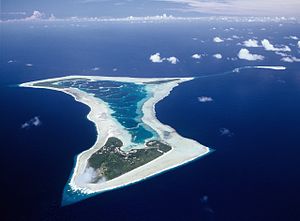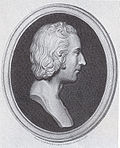- Pukapuka
-
This article is about Pukapuka in the Cook Islands. For the coral atoll in French Polynesia, see Puka-Puka.
Pukapuka is a coral atoll in the Cook Islands in the Pacific Ocean, with three small islets threaded on a reef, which encloses a beautifully clear lagoon. It is one of the most remote islands of the Cook Islands, situated about 1315 kilometres northwest of Rarotonga. It is a triangular atoll with three islets comprising little more than 3 square kilometres of land area, yet on this small island an ancient culture and distinct language developed over many centuries. Archaeologists have recently discovered evidence of human settlement as early as approximately 2,000 years ago, and the closest prehistoric associations appear to be with Samoa and other islands to the west. The old name for the atoll was Te Ulu-o-Te-Watu ('the head of the stone'), and the northern islet where the people normally reside is affectionately known as Wale (Home).
Contents
European visitors
Pukapuka has the distinction of being the first of the Cook Islands to be sighted by Europeans. The Spanish explorer Alvaro de Mendana de Neira saw it on Saint Bernard's day, Sunday 20 August 1595 and named it San Bernardo.
Of the inhabited islands in the Cook group, Pukapuka is probably the most isolated. On 21 June 1765 the British Naval expedition under Commodore John Byron ("Dolphin" and "Tamar") sighted the island. He gave the name "Islands of Danger" because of the high surf that made it too dangerous to land. The name "Danger Island" still appears on some maps. (It should not be confused with Danger Island of the Chagos Archipelago in the Indian Ocean.)
Thirty years later, Pukapuka was given the name "Isles de la Loutre" (Isles of the Otter) by Pierre François Péron, the first mate on board the American merchant ship, Otter (ship) (Captain Ebenezer Dorr) when it was sighted on 3 April 1796. The following day, Peron, Thomas Muir of Huntershill (1765–1799) and a small party landed ashore but the inhabitants did not allow them to inspect the island. Trading took place near the ship as adzes, mats and other artifacts were exchanged for knives and European goods.[1]
"Everything united to convince us that we had the right to attribute to ourselves the honour of having discovered three new islands; and with this conviction I gave them the name of Otter Islands [Isles de la Loutre] which was the name of our vessel. In order to distinguish them we named the eastern one 'Peron and Muir' (Motu Ko), the one to the north 'Dorr' (Pukapuka), and the name of 'Brown' (Motu Kotowa) was given to the third, after one of our officers." Peron[1]
Due to its isolation, few vessels visited it before 1857 when the London Missionary Society landed teachers from Rarotonga and Aitutaki. In 1862, Rev. Wyatt W. Gill found most of the people on the island converted to Christianity. Peruvian slavers raided the island in early 1863 and took away a total of 145 men and women; only two returned. The English missionary barque "John Williams" was wrecked on the west side in May 1864.[2]
World War II
Three downed U.S. Navy fliers landed on Pukapuka in February 1942. Harold Dixon, Gene Aldrich, and Tony Pastula survived 34 days on the open ocean in a tiny 4 by 8 foot (1.2 by 2.4 m) raft, beginning their odyssey with no food or water stores and very few tools. Shortly after their arrival a typhoon struck the island. Their story has been called "…unquestionably one of the most grueling and fantastic ordeals of World War II."[3]
Geography
Pukapuka is shaped like a three bladed fan. There are three islets on the roughly triangular reef. Motu Ko, the biggest island is to the southeast; Motu Kotawa (Frigate Bird Island) is to the southwest; and the main island Wale is to the north. Ko and Kotawa are uninhabited and are used for growing food. The airport (ICAO airport code: NCPK) is on Ko.
The three villages are located on the crescent-shaped bay of the northernmost islet of the atoll: Yato (Leeward), Loto (Central) and Ngake (East). Loto (Roto on some older maps) is the seat of the Pukapuka Island Administration. The traditional names for these villages are Takanumi, Kotipolo and Te Langaikula. In daily life, the islanders frequently call them Tiapani (Japan), Malike or Amelika (USA) and Olani (Holland) respectively. Especially in sports competitions between the villages, the villagers use the names and flags of these countries.
Although the island features a well-maintained airstrip, flights from Rarotonga are very infrequent. The island is closer to Samoa than to the rest of the Cook Islands. The five hour flight from Rarotonga now operates when there is a Government charter once every six weeks or so.
The submerged Tema Reef is situated 23 km southeast of Pukapuka. About 60 km away is Nassau (Cook Islands) which is owned by the people of Pukapuka and considered part of it administratively. Since the 1950s it has been governed by a Council of Chiefs of Pukapuka. The Nassau Island Committee advises the Pukapuka Island Committee on matters relating to its own island.
Pukapuka and Nassau were hit by Cyclone Percy in February 2005 — a Category Four cyclone that destroyed the taro gardens, brought down thousands of trees, and damaged three-quarters of the houses.
Treaty
The United States gave up its claim to the island in a treaty signed with the Cook Islands on 11 June 1980.
Culture
Pukapuka has its own language and customs, and other Cook Islanders say its main asset is its “beautiful girls”. Its name derives from the puka tree which is commonplace.
The entire population is said to be descended from just two women, seventeen men, and an unknown number of children who survived a catastrophic storm and tidal wave (tsunami) in the early 17th century.[4] 664 people inhabited the island as of the 2001 census.
The late American writer Robert Dean Frisbie settled on Pukapuka in 1924 and immortalised the island in the books he wrote about it. He said at the time he was looking for a place beyond the reach of "the faintest echo from the noisy clamour of the civilised world". He found it, and to this day Pukapuka is one of the most untouched and secluded places in the Cook Islands.
See also
- Pukapukan language
- List of Guano Island claims
References
- ^ a b Pierre François PÉRON (1824). Mémoires du Capitaine Péron, sur ses Voyages aux Côtes d’Afrique, en Arabie, a l’Île d’Amsterdam, aux Îles d’Anjouan et de Mayotte, aux Côtes Nord-Oeust de l’Amérique, aux Îles Sandwich, a la Chine, etc.. Paris: Brissot-Thivars. http://books.google.com.au/books?id=meR6RQAACAAJ. Retrieved 31 July 2010.
- ^ Beaglehole, Earnest and Pearl (1938). "Ethnology of Pukapuka," Bernice P. Bishop Museum Bulletin, 150.
- ^ Through Enemy Lines, Phil Hirsch, editor ; Pyramid Books, NY, NY, 1967.
- ^ Beaglehole and Beaglehole (1938).
External links
Coordinates: 10°53′S 165°51′W / 10.883°S 165.85°W
Northern 
Southern - Nga-pu-Toru Southern - other Categories:- Double-named places
- Atolls of the Cook Islands
- Islands claimed under the Guano Islands Act
- Former regions and territories of the United States
- Territorial disputes of the Cook Islands
- Pukapuka
- Cook Islands–United States relations
- World War II sites
Wikimedia Foundation. 2010.



